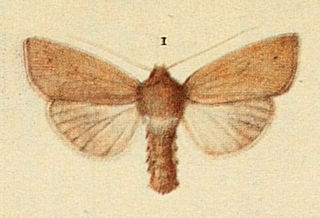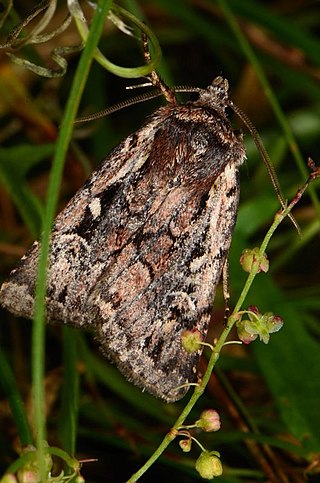
Mythimna ferrago, the clay, is a moth of the family Noctuidae. The species was first described by Johan Christian Fabricius in 1787. It is distributed throughout Europe and is also found in Morocco, Algeria, Turkey, Asia Minor, Armenia, Syria, Turkestan, Israel, Lebanon, Iraq, Iran, Central Asia and the western parts of temperate North Asia. Also Tibet.

Mythimna impura, the smoky wainscot, is a moth of the family Noctuidae. The species was first described by Jacob Hübner in 1808. It is distributed throughout most of the Palearctic realm from Ireland in the west of Europe east to the Caucasus, Turkey, Syria, Kazakhstan, Russia, Siberia, Mongolia, then Japan. In Europe it is found from the Arctic Circle to Spain and Italy in the south, as well as in the northern regions of Greece.

Mythimna pallens, the common wainscot, is a moth of the family Noctuidae distributed throughout the Palearctic realm from Ireland in the west, through Europe to Central Asia and Amur to the Kuriles in the east. The species was first described by Carl Linnaeus in his 1758 10th edition of Systema Naturae.

The shoulder-striped wainscot is a moth of the family Noctuidae. The species was first described by Carl Linnaeus in 1761. Some authors place it in the genus Mythimna. It is found throughout Europe and in Russia to the west of the Urals.

Mythimna albipuncta, the white-point, is a moth of the family Noctuidae. The species was first described by Michael Denis and Ignaz Schiffermüller in 1775. It is distributed throughout Europe and one subspecies is found in Tunisia. It is also found in Asia Minor, Armenia, and Iran, and the northeastern United States.

Mythimna l-album, the L-album wainscot, is a moth of the family Noctuidae. The species was first described by Carl Linnaeus in his 1767 12th edition of Systema Naturae. It is distributed throughout Europe, but is also found in North Africa from Morocco to Tunisia and in the Levant, then east across the Palearctic to Central Asia. It is not found in the far north of the Arabian Peninsula. The limit in the north varies. It occurs on the northern edge of the range as a migrant. From southern England, then Denmark and southern Scandinavia, the north limit cuts across the Baltic Sea across the Baltic states then south of Moscow to the Urals.

Mythimna vitellina, the delicate, is a moth of the family Noctuidae. The species was first described by Jacob Hübner in 1808. It is mainly distributed throughout southern Europe and the southern part of eastern Europe. It is also found far less commonly further north in Europe. Also in North Africa, the Near East and Middle East, Central Asia and western China.

Mythimna pudorina, the striped wainscot, is a species of moth of the family Noctuidae. It is found in the Palearctic realm. Also Armenia, Asia Minor and eastern Siberia.

The flame wainscot is a species of moth of the family Noctuidae. It is found from Europe and across the Palearctic to Japan, but is not found on the Iberian Peninsula, the islands in the Mediterranean Sea, Greece and central and southern Italy.

Mythimna straminea, the southern wainscot, is a moth of the family Noctuidae. The species was first described by Georg Friedrich Treitschke in 1825. It is found in the western parts of the Palearctic realm, including Morocco, Europe, Turkey, the Caucasus, Israel, and Lebanon.

Mythimna turca, the double line, is a moth of the family Noctuidae. The species was first described by Carl Linnaeus in 1761. It is found in Europe. The eastern expansion extends through northern Asia and central Asia to northern China, Korea and Japan. It rises to a height of about 700 metres in the Alps.

Mythimna conigera, the brown-line bright-eye, is a moth of the family Noctuidae.

Mythimna favicolor, or Mathew's wainscot, is a moth of the family Noctuidae. The species was first described by Charles Golding Barrett in 1896. It is found in Europe. The species is sometimes treated as a subspecies of Mythimna pallens, the common wainscot.

Mythimna obsoleta, the obscure wainscot, is a moth of the family Noctuidae. The species was first described by Jacob Hübner in 1803. It is found in Europe, from southern Fennoscandia to Spain, Italy and the Balkans, the European part of Russia, the Caucasus, Kazakhstan, Kyrgyzia, southern Siberia, Turkey, the Ural, Mongolia, the Russian Far East, the Korean Peninsula, China and Hokkaido and Honshu in Japan.

Leucania loreyi, the cosmopolitan, false army worm or nightfeeding rice armyworm, is a moth of the family Noctuidae. It is found in most of African countries, the Indo-Australian subtropics and tropics of India, Sri Lanka, Myanmar, the eastern Palearctic realm, and the Near East and Middle East. The species was first described by Philogène Auguste Joseph Duponchel in 1827.

Xestia agathina, the heath rustic, is a moth of the family Noctuidae. It is found in western and central Europe and Morocco.

Chilodes maritimus, the silky wainscot, is a moth of the family Noctuidae. It is found in most of Europe including Russia.

Sideridis turbida, the white colon, is a moth of the family Noctuidae, subfamily Hadeninae. It is found throughout continental Europe, the British Isles and southern Scandinavia.

The Brighton wainscot is a moth of the family Noctuidae.

Archanara neurica, the white-mantled wainscot, is a nocturnal moth of the family Noctuidae described by Jacob Hübner in 1808. It is found in Austria, Belgium, Bosnia and Herzegovina, Great Britain, Bulgaria, Croatia, the Czech Republic, Denmark, France, Germany, Hungary, Italy, Latvia, Liechtenstein, North Macedonia, Poland, Romania, Sicily, Slovakia, Slovenia, Switzerland, the Netherlands and Serbia. In the UK, its only regular sites are at RSPB Minsmere and Walberswick National Nature Reserve in Suffolk.























